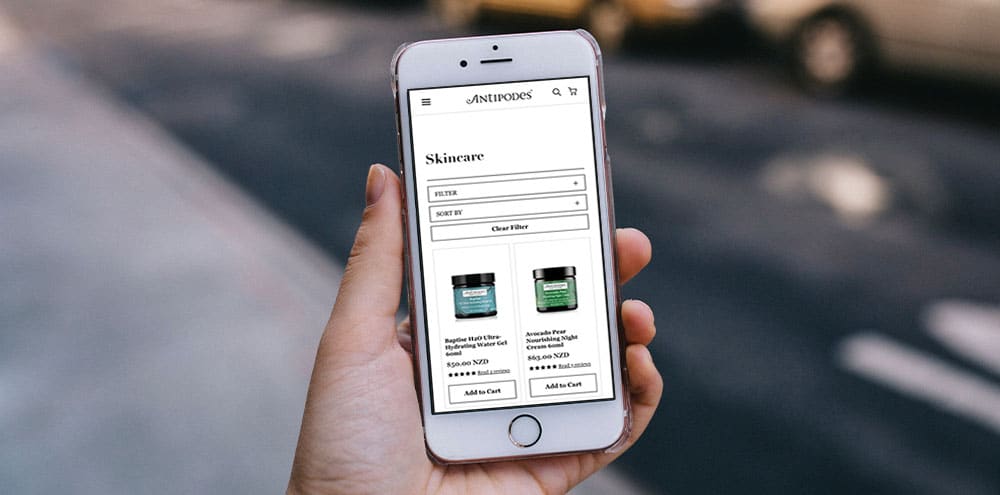In the competitive online marketplace, you have seconds to capture a visitor’s attention. Here’s how to do it with these web design tips for eCommerce websites.
The requirements of eCommerce websites are unique, and designing a new site can seem overwhelming. However, these tips will help you create an online store that both looks great and generates sales.
1. Step into your customers’ shoes
Looking at things from a potential customer’s perspective will help you understand how to optimise the website experience. What are they looking for? How will they find what they need? What would make their purchase process hassle-free?
2. Content marketing
Rows of product, images and text crammed into limited space can be overwhelming for your website visitors and will increase your bounce rate. Let your images do the talking, prominent calls to action and a simple layout to make navigation easy.
3. Be intuitive
Think hard about your navigation menu and how you categorise products on the page so it’s as straightforward as possible. Search functionality is worthwhile to help people find what they’re looking for.
4. Use high-quality visuals
Professional product images will capture the attention of visitors and help drive engagement. Just maintain your site speed by using smaller image files that will affect the image quality but will help your pages load faster, creating a better user experience (not to mention contributing to a more eco-friendly website).

5. Make your USPs prominent
While your products need to shine, you also need to convince people why they should purchase from you. Whether you offer a flexible returns policy or have a sustainable ethos, make sure your website communicates how you stand out from your competitors.
6. Tailor your web design to both new and returning visitors
New visitors will likely be looking for educational resources or to learn more about your brand. Returning or signed-in visitors will already be familiar with your business. Consider offering a special discount for new customers to encourage them to purchase, and using cookie targeting to present returning visitors with special promotions.
7. Identify key touchpoints
There’s ample opportunity to connect with website visitors, and working these into your website design is a key part of customer journey mapping. A pop up form, chat bot, Facebook retargeting ad or gentle email reminder at the right time could help increase your conversions.
8. Set up goals in Google Analytics
Set up goals based on the actions you want your website visitors to take to give you visibility as to whether you’re achieving them. Regularly cleaning your Google Analytics data will ensure you’re getting the most accurate metrics, too.
9. Optimise your web design for mobile
People will visit your website on different devices. A responsive web design creates a consistent, positive user experience whether someone’s browsing your products on their smartphone, tablet or desktop computer.

10. Get the checkout experience right
Someone’s already come this far, so make the final step as easy as possible. Functionality like auto-populating forms or letting customers purchase without creating an account can minimise last-minute hassles that can prevent someone from purchasing.
11. Keep the bigger picture in mind
It’s vital your website is part of a wider digital marketing strategy. The web design on its own won’t bring people to the site; the activity you’re doing elsewhere will drive people there. That’s why it’s a good idea to choose a website design agency that also provides digital marketing services.
12. Pick the right CMS platform
When determining which CMS platform is best for your eCommerce business, Shopify is a clear frontrunner. With its built-in analytics, hassle-free payments and an App Store offering all the functionality and integrations you need, it’s the platform of choice for eCommerce.
13. Test extensively
You’ll be able to test your website before it goes live, but let the first month or two be a trial period for your new site. Gauge how people are interacting with the content and whether the design is working.
14. Adapt
Your testing may indicate that some slight design changes are required. Simply changing the size or placement of a call to action button could result in a significantly higher conversion rate, so remain agile and adjust for better results where you can.
15. Work with a web agency specialising in eCommerce websites
It’s essential you work with an agency that understands the eCommerce space. At NZ Digital, we’ve developed Shopify websites for a range of eCommerce clients and have the experience where it counts.
Get in touch with our friendly team today to get the process started. Talk to us about how we can help.








